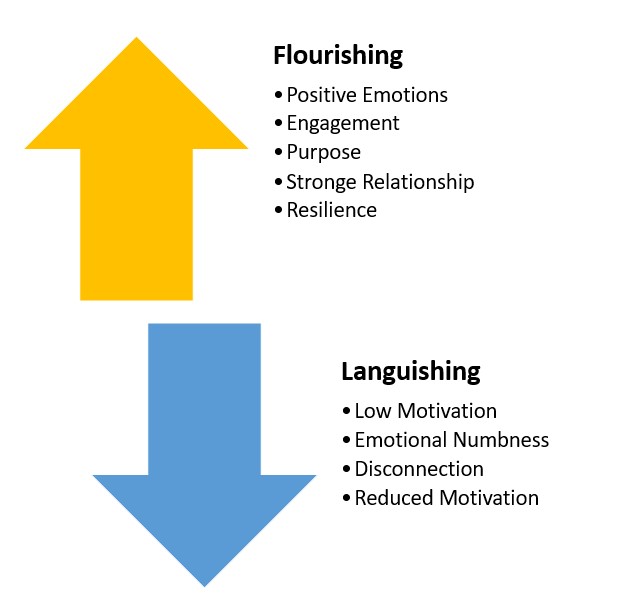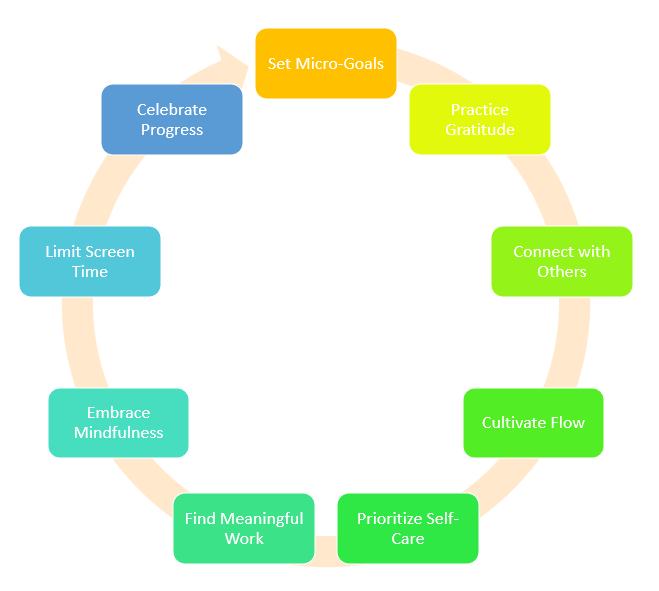In the complex spectrum of mental health, we often hear about depression, anxiety, or thriving. However, two concepts—languishing and flourishing—have recently gained attention, particularly in discussions of post-pandemic mental health. Understanding these states can help us navigate personal challenges, recognize areas for growth, and ultimately work towards a more fulfilling life.

What is Languishing?
Coined by sociologist Corey Keyes, languishing is a state of emotional stagnation and emptiness. It is not depression, as it lacks the pervasive hopelessness and severe symptoms. Instead, languishing is characterized by a sense of aimlessness and a lack of engagement in life. People who languish may describe feeling “stuck,” unmotivated, or indifferent. They aren’t mentally unwell, but they are also far from thriving.
Characteristics of Languishing-
- Low Motivation- Feeling uninspired to pursue goals or engage in hobbies.
- Emotional Numbness- Experiencing a lack of joy or sadness, instead feeling neutral or flat.
- Disconnection- Struggling to find purpose or meaning in daily activities.
- Reduced Productivity- Difficulty focusing, leading to procrastination or decreased work performance.
Read More- Mental Health
What is Flourishing?
On the opposite end of the spectrum lies flourishing, a term also popularized by Corey Keyes. Flourishing refers to a state of optimal mental health where individuals feel deeply engaged, purposeful, and content. It goes beyond the absence of mental illness to encompass positive emotions, meaningful relationships, and a strong sense of personal growth.
Characteristics of Flourishing-
- Positive Emotions- Feeling joy, gratitude, and optimism regularly.
- Engagement- Being fully immersed in activities that align with personal interests and values.
- Purpose- Having a clear sense of direction or goals.
- Strong Relationships- Feeling connected and supported by others.
- Resilience- Bouncing back from challenges and learning from failures.

How to Recognize Languishing?
Languishing can act as a silent drain on well-being, leading to long-term mental health issues if not addressed. According to Keyes’ research, individuals who languish are at higher risk of developing depression or anxiety over time. Recognizing and addressing languishing early can prevent this downward spiral.
Signs You Might Be Languishing-
- You often feel “meh” about your day-to-day life.
- Tasks that once excited you now feel mundane or exhausting.
- You find yourself zoning out or lacking focus.
- Social interactions feel draining or unimportant.
- You struggle to identify what truly makes you happy.
Read More- Satisficing
Transitioning from Languishing to Flourishing
If you recognize signs of languishing, the good news is that small, intentional actions can help move you towards flourishing. Here are evidence-based strategies to avoid languishing and promote flourishing-

1. Set Micro-Goals
- Achieving even small goals can trigger a dopamine release, boosting motivation and a sense of accomplishment. (Sinek, 2019)
- Start with simple tasks, such as journaling for five minutes a day, organizing your workspace, or setting a weekly fitness goal.
2. Practice Gratitude
- Studies show that regularly practicing gratitude increases happiness and life satisfaction. (Emmons & McCullough, 2003)
- Write down three things you’re grateful for each day. Focus on specific details, such as “a kind text from a friend” or “the warmth of sunlight through the window.”
3. Connect with Others
- Positive social relationships are a core component of flourishing. They provide emotional support and increase feelings of belonging. (Diener & Seligman, 2002)
- Schedule time for meaningful conversations with friends or family. Join a local community group or volunteer to meet new people.
4. Cultivate Flow
- Flow, a term coined by psychologist Mihaly Csikszentmihalyi, occurs when you are fully absorbed in an activity. It leads to increased satisfaction and reduces feelings of stagnation.
- Identify activities that challenge and engage you, such as painting, playing music, or coding. Dedicate uninterrupted time to focus on these pursuits.
5. Prioritize Self-Care
- Basic habits like sleeping well, eating nutritious foods, and exercising improve mood and energy levels. (Walker, 2017)
- Create a consistent routine that includes 7–9 hours of sleep, daily movement (even if it’s a short walk), and balanced meals.
6. Find Meaningful Work
- Engaging in work that aligns with your values enhances purpose and well-being. (Wrzesniewski et al., 1997)
- Reflect on what aspects of your job you find fulfilling. If possible, focus more on those areas or consider transitioning to a role that aligns with your passions.
7. Embrace Mindfulness
- Mindfulness reduces stress and improves focus by helping you stay present. (Kabat-Zinn, 1990)
- Incorporate mindfulness practices, such as meditation, deep breathing, or simply observing your surroundings without judgment.
8. Limit Screen Time
- Excessive screen time, particularly on social media, is linked to feelings of inadequacy and disconnection. (Twenge & Campbell, 2018)
- Set boundaries, like no screens during meals or before bedtime. Replace scrolling with activities like reading or spending time outdoors.
9. Celebrate Progress
- Recognizing even small achievements fosters positive emotions and reinforces productive habits. (Amabile & Kramer, 2011)
- At the end of each day, write down one thing you accomplished. Reflect on how it contributes to your broader goals.
Building a Flourishing Life
Transitioning from languishing to flourishing is not an overnight process. It requires consistent effort and self-reflection. By incorporating small, intentional practices like setting goals, fostering connections, and prioritizing self-care, you can create a life rich in meaning and joy.
Remember, flourishing isn’t about eliminating every stressor or achieving perfection. Instead, it’s about finding balance, cultivating resilience, and embracing the activities, people, and values that bring out your best self.
References
Corey L. M. Keyes (2002). The mental health continuum: From languishing to flourishing in life. Journal of Health and Social Behavior.
Emmons, R. A., & McCullough, M. E. (2003). Counting blessings versus burdens: An experimental investigation of gratitude and subjective well-being. Journal of Personality and Social Psychology.
Diener, E., & Seligman, M. E. P. (2002). Very happy people. Psychological Science.
Csikszentmihalyi, M. (1990). Flow: The Psychology of Optimal Experience. Harper & Row.
Twenge, J. M., & Campbell, W. K. (2018). Associations between screen time and lower psychological well-being among children and adolescents. Preventive Medicine Reports.
Walker, M. (2017). Why We Sleep: Unlocking the Power of Sleep and Dreams. Scribner.
Sinek, S. (2019). Start with Why: How Great Leaders Inspire Everyone to Take Action. Penguin.
Subscribe to PsychUniverse
Get the latest updates and insights.
Join 3,022 other subscribers!
Niwlikar, B. A. (2025, January 8). Transition from Languishing to Flourishing in 9 Easy Steps. PsychUniverse. https://psychuniverse.com/languishing-to-flourishing/




